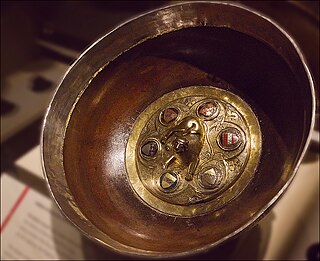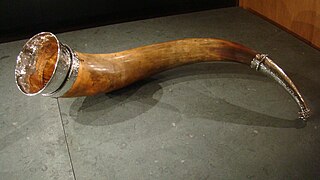
A teapot is a vessel used for steeping tea leaves or a herbal mix in boiling or near-boiling water, and for serving the resulting infusion which is called tea. It is one of the core components of teaware. Dry tea is available either in tea bags or as loose tea, in which case a tea infuser or tea strainer may be of some assistance, either to hold the leaves as they steep or to catch the leaves inside the teapot when the tea is poured. Teapots usually have an opening with a lid at their top, where the dry tea and hot water are added, a handle for holding by hand and a spout through which the tea is served. Some teapots have a strainer built-in on the inner edge of the spout. A small air hole in the lid is often created to stop the spout from dripping and splashing when tea is poured. In modern times, a thermally insulating cover called a tea cosy may be used to enhance the steeping process or to prevent the contents of the teapot from cooling too rapidly.

Repoussé or repoussage ( ) is a metalworking technique in which a malleable metal is shaped by hammering from the reverse side to create a design in low relief. Chasing or embossing is a similar technique in which the piece is hammered on the front side, sinking the metal. The two techniques are often used in conjunction.

A mug is a type of cup typically used for drinking hot drinks, such as coffee, hot chocolate, or tea. Mugs usually have handles and hold a larger amount of fluid than other types of cups. Typically, a mug holds approximately 240–350 ml of liquid. A mug is a less formal style of drink container and is not usually used in formal place settings, where a teacup or coffee cup is preferred. Shaving mugs are used to assist in wet shaving.

A vase is an open container. It can be made from a number of materials, such as ceramics, glass, non-rusting metals, such as aluminium, brass, bronze, or stainless steel. Even wood has been used to make vases, either by using tree species that naturally resist rot, such as teak, or by applying a protective coating to conventional wood or plastic. Vases are often decorated, and they are often used to hold cut flowers. Vases come in different sizes to support whatever flower is being held or kept in place.

A bowl is a typically round dish or container generally used for preparing, serving, or consuming food. The interior of a bowl is characteristically shaped like a spherical cap, with the edges and the bottom forming a seamless curve. This makes bowls especially suited for holding liquids and loose food, as the contents of the bowl are naturally concentrated in its center by the force of gravity. The exterior of a bowl is most often round, but can be of any shape, including rectangular.

A krater or crater was a large two-handled type of vase in Ancient Greek pottery and metalwork, mostly used for the mixing of wine with water.

A mazer is a special type of wooden drinking vessel, a wide cup or shallow bowl without handles, with a broad flat foot and a knob or boss in the centre of the inside, known technically as the print or boss. They vary from simple pieces all in wood to those ornamented with metalwork, often in silver or silver-gilt. They use dense impervious woods such as maple, beech and walnut wood. They are a north European medieval tradition, mostly made from the 11th to the 16th centuries.

A drinking horn is the horn of a bovid used as a drinking vessel. Drinking horns are known from Classical Antiquity, especially the Balkans, and remained in use for ceremonial purposes throughout the Middle Ages and the Early Modern period in some parts of Europe, notably in Germanic Europe, and in the Caucasus. Drinking horns remain an important accessory in the culture of ritual toasting in Georgia in particular, where they are known by the local name of kantsi.

The Yale University Art Gallery (YUAG) is the oldest university art museum in the Western Hemisphere. It houses a major encyclopedic collection of art in several interconnected buildings on the campus of Yale University in New Haven, Connecticut. Although it embraces all cultures and periods, the gallery emphasizes early Italian Renaissance painting, African sculpture, and modern art.

Beer glassware comprise vessels made of glass, designed or commonly used for serving and drinking beer. Styles of glassware vary in accord with national or regional traditions; legal or customary requirements regarding serving measures and fill lines; such practicalities as breakage avoidance in washing, stacking or storage; commercial promotion by breweries; artistic or cultural expression in folk art or as novelty items or usage in drinking games; or to complement, to enhance, or to otherwise affect a particular type of beer's temperature, appearance and aroma, as in the case of its head. Drinking vessels intended for beer are made from a variety of materials other than glass, including pottery, pewter, and wood.

In modern usage, an aquamanile is a ewer or jug-type vessel in the form of one or more animal or human figures. It usually contained water for the washing of hands over a basin, which was part of both upper-class meals and the Christian Eucharist. Historically the term was used for a basin used for priest's ablutions. The water was supplied by a subdeacon, and aquamanile was a symbol of subdeaconate. The term was later transferred onto secular ewers. Most surviving examples are in metal, typically copper alloys, as pottery versions have rarely survived.

Hillwood Estate, Museum & Gardens is a decorative arts museum in Washington, D.C., United States. The former residence of businesswoman, socialite, philanthropist and collector Marjorie Merriweather Post, Hillwood is known for its large decorative arts collection that focuses heavily on the House of Romanov, including Fabergé eggs. Other highlights are 18th- and 19th-century French art and one of the country's finest orchid collections.

Shan shui refers to a style of traditional Chinese painting that involves or depicts scenery or natural landscapes, using a brush and ink rather than more conventional paints. Mountains, rivers and waterfalls are common subjects of shan shui paintings.

Sets and individual examples of ritual bronzes survive from when they were made mainly during the Chinese Bronze Age. Ritual bronzes create quite an impression both due to their sophistication of design and manufacturing process, but also because of their remarkable durability. From around 1650 BCE, these elaborately decorated vessels were deposited as grave goods in the tombs of royalty and the nobility, and were evidently produced in very large numbers, with documented excavations finding over 200 pieces in a single royal tomb. They were produced for an individual or social group to use in making ritual offerings of food and drink to his or their ancestors and other deities or spirits. Such ceremonies generally took place in family temples or ceremonial halls over tombs. These ceremonies can be seen as ritual banquets in which both living and dead members of a family were supposed to participate. Details of these ritual ceremonies are preserved through early literary records. On the death of the owner of a ritual bronze, it would often be placed in his tomb, so that he could continue to pay his respects in the afterlife; other examples were cast specifically as grave goods. Indeed, many surviving examples have been excavated from graves.

Fatimid art refers to artifacts and architecture from the Fatimid Caliphate (909–1171), an empire based in Egypt and North Africa. The Fatimid Caliphate was initially established in the Maghreb, with its roots in a ninth-century Shia Ismailist Many monuments survive in the Fatimid cities founded in North Africa, starting with Mahdia, on the Tunisian coast, the principal city prior to the conquest of Egypt in 969 and the building of al-Qahira, the "City Victorious", now part of modern-day Cairo. The period was marked by a prosperity amongst the upper echelons, manifested in the creation of opulent and finely wrought objects in the decorative arts, including carved rock crystal, lustreware and other ceramics, wood and ivory carving, gold jewelry and other metalware, textiles, books and coinage. These items not only reflected personal wealth, but were used as gifts to curry favour abroad. The most precious and valuable objects were amassed in the caliphal palaces in al-Qahira. In the 1060s, following several years of drought during which the armies received no payment, the palaces were systematically looted. The libraries largely destroyed, precious gold objects melted down, with a few of the treasures dispersed across the medieval Christian world. Afterwards Fatimid artifacts continued to be made in the same style, but were adapted to a larger populace using less precious materials.

In ecclesiastical architecture, a ciborium is a canopy or covering supported by columns, freestanding in the sanctuary, that stands over and covers the altar in a basilica or other church. It may also be known by the more general term of baldachin, though ciborium is often considered more correct for examples in churches. Really a baldachin should have a textile covering, or at least, as at Saint Peter's in Rome, imitate one. There are exceptions; Bernini's structure in Saint Peter's, Rome is always called the baldachin.

Hardstone carving, in art history and archaeology, is the artistic carving of semi-precious stones, such as jade, rock crystal, agate, onyx, jasper, serpentinite, or carnelian, and for objects made in this way. Normally the objects are small, and the category overlaps with both jewellery and sculpture. Hardstone carving is sometimes referred to by the Italian term pietre dure; however, pietra dura is the common term used for stone inlay work, which causes some confusion.

Ancient furniture was made of many different materials, including reeds, wood, stone, metals, straws, and ivory. It could also be decorated in many different ways. Sometimes furniture would be covered with upholstery, upholstery being padding, springs, webbing, and leather. Features which would mark the top of furniture, called finials, were common. To decorate furniture, contrasting pieces would be inserted into depressions in the furniture. This practice is called inlaying.

Abumi (鐙), Japanese stirrups, were used in Japan as early as the 5th century, and were a necessary component along with the Japanese saddle (kura) for the use of horses in warfare. Abumi became the type of stirrup used by the samurai class of feudal Japan.

A needlecase or needle case is a small, often decorative, holder for sewing needles. Early needlecases were usually small tubular containers of bone, wood, or bronze with tight-fitting stoppers, often designed to hang from a belt. Needlecases are sometimes called by the French name étui and are typically one of the tools attached to a chatelaine. A pin poppet is a similar container for pins, common in the 18th century.





















